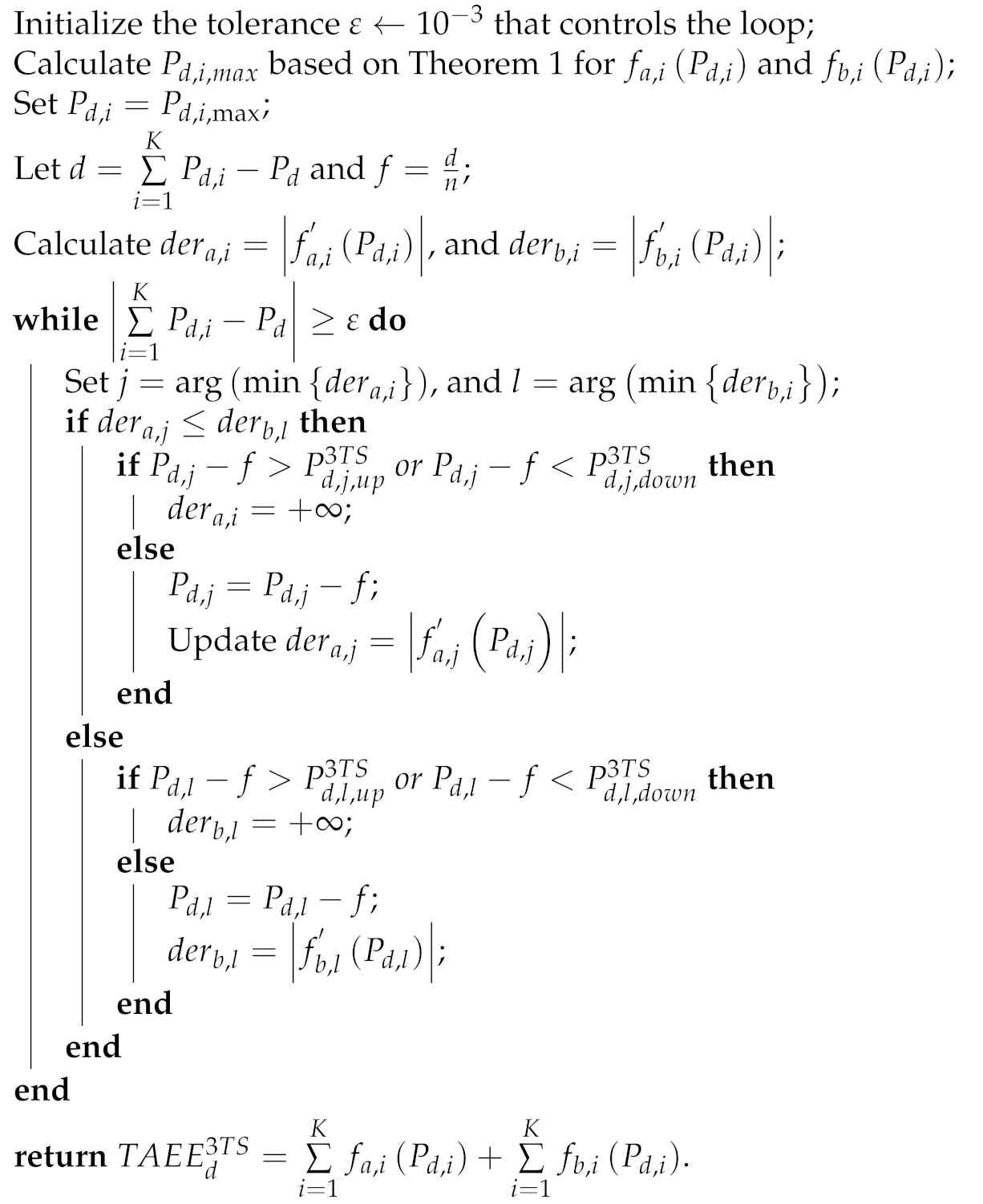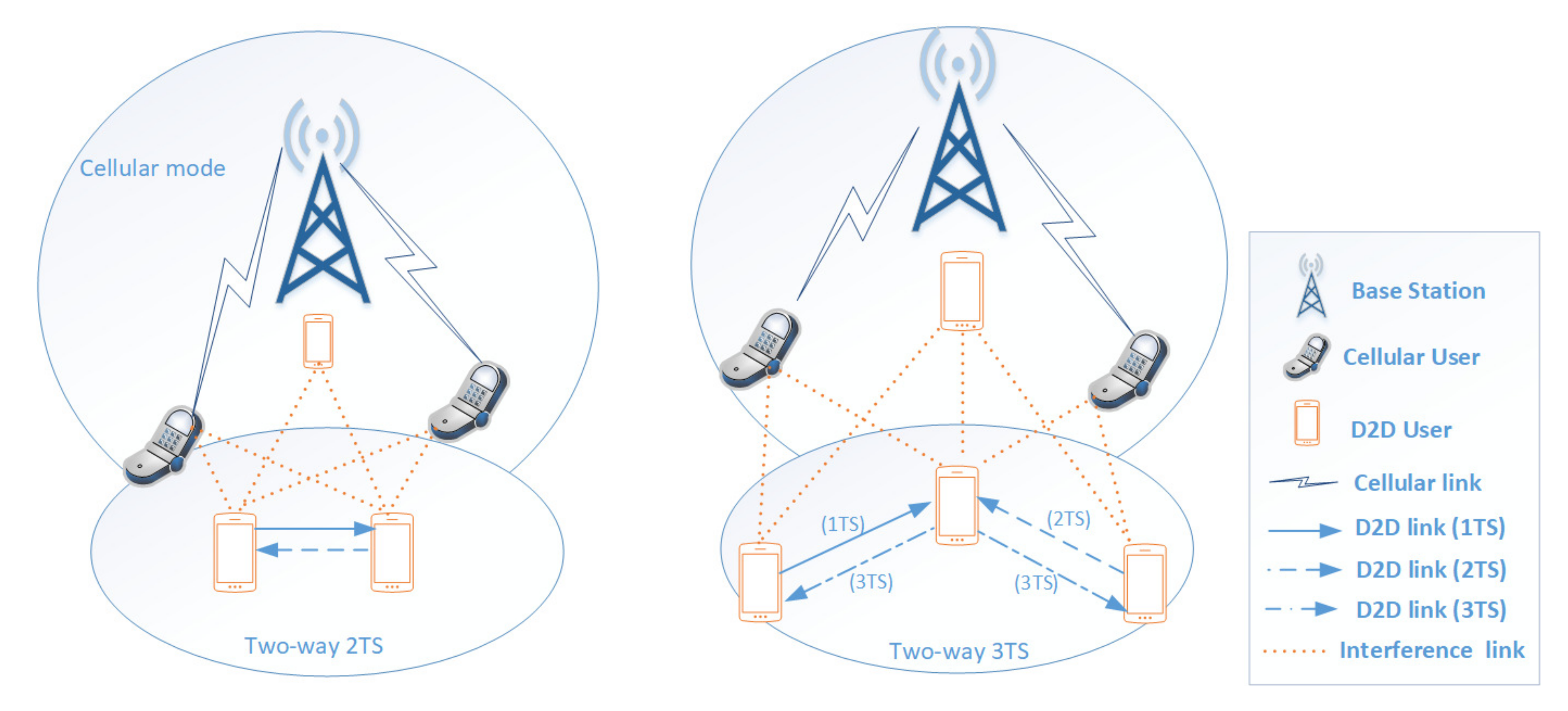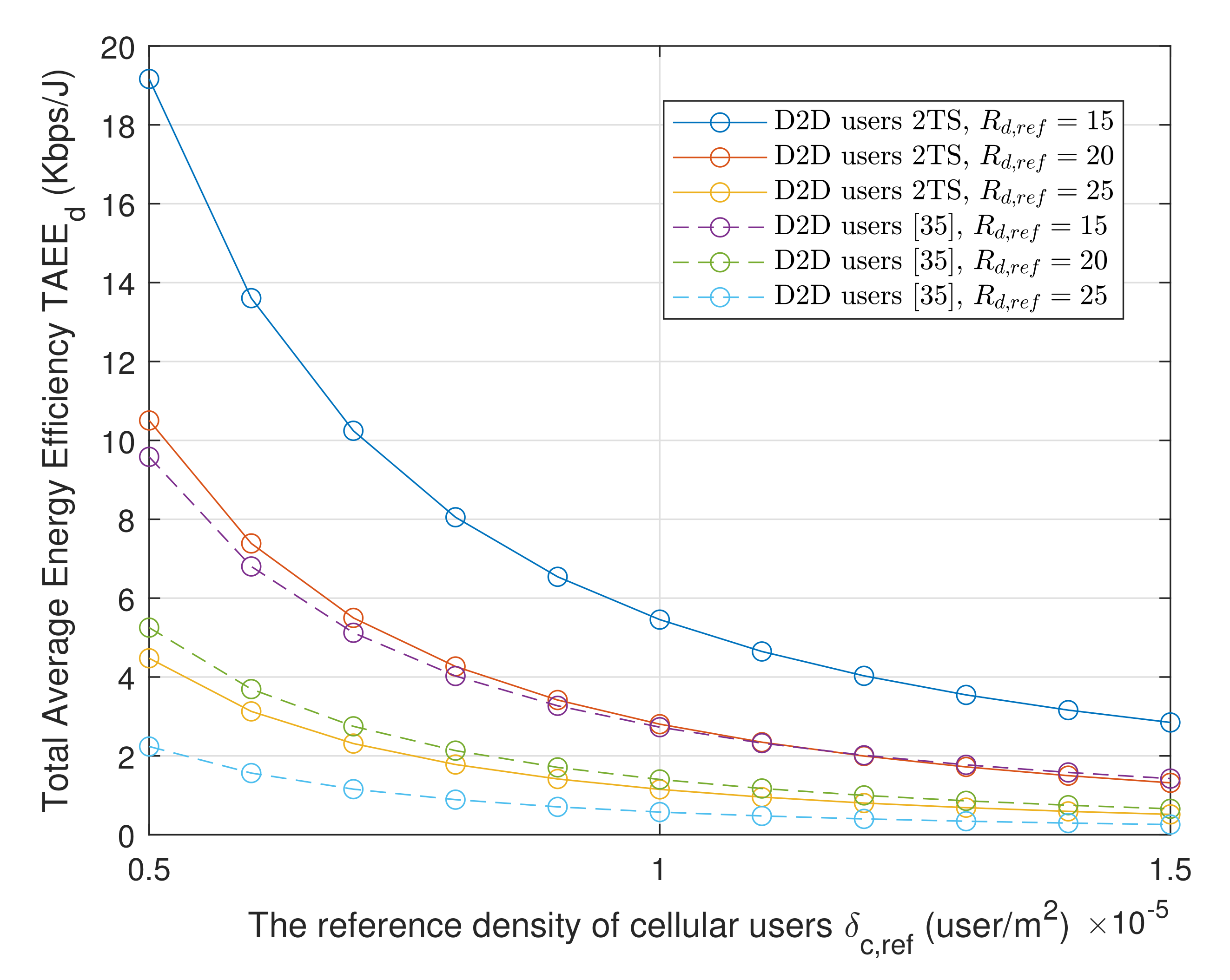Energy Efficiency Maximization of Two-Time-Slot and Three-Time-Slot Two-Way Relay-Assisted Device-to-Device Underlaying Cellular Networks
Abstract
:1. Introduction
1.1. Related Work
1.2. Main Contributions
- Firstly, the closed-form expressions for the STP, the TATR, and the TAEE for the cellular users and D2D users in 2TS and 3TS mode of the two-way D2D communication network are derived.
- Secondly, there is a proposed optimization problem aiming at maximizing the EE of D2D users while ensuring the QoS of the cellular and D2D users. This problem is solved thanks to a DB algorithm formulated from the fact that the multi-hop D2D users are subject to transmission power and OP constraints. This problem is proven to be non-convex and separated into two sub-problems. Solving the first sub-problem provides the maximized EE of the D2D users along with the optimum transmission power of the direct (one-hop) D2D user in 2TS mode. In the second sub-problem, an objective function is formulated to calculate the maximized EE and the optimum transmission power of the D2D users in 3TS mode with a two-way relay assisting the communication (multi-hop). It is noteworthy that the objective function is a sum of a number of sub-functions. When all of the sub-functions are maximized, by summing them up, it is possible to obtain the optimal result for the second sub-problem.
- Finally, a comparison between this study and the study in [31,32] given similar system model and assumptions is done. It can be observed from the simulation results that the DB algorithm provides a near-optimal solution in 2TS and an outstanding performance in 3TS comparing to the conventional Branch and Bound (BB) algorithm [33].
2. System Model
- Two-time-slot (2TS) mode: direct, one-hop communication.
- Three-time-slot (3TS) mode: indirect, via an in-between D2D user working as a two-way relay to assist the signal transmission, multi-hop communication.
3. Problem Formulation
3.1. The Signal to Noise Plus Interference Ratio
3.2. The Successful Transmission Probability of Typical Receivers
4. Performance Energy Efficiency
Total Average Transmissions Rate and Total Average Energy Efficiency
5. Optimization Problem
5.1. Optimization Total Average Energy Efficiency in 2TS
5.2. Optimization Total Average Energy Efficiency in 3TS
5.3. Derivative-Based Algorithm
- Provided that , then there is a monotonic increase of on the feasible region. Hence, reaches its maximum at leading to .
- Provided that , then the global maximum of is located within the feasible region leading to .
- Provided that , then there is a monotonic decrease of on the feasible region. Hence, reaches its maximum at .
| Algorithm 1: The DB algorithm for 2TS |
 |
| Algorithm 2: The DB algorithm for 3TS |
 |
6. Numerical Results
7. Conclusions
Author Contributions
Funding
Acknowledgments
Conflicts of Interest
References
- Tehrani, M.N.; Uysal, M.; Yanikomeroglu, H. Device-to-device communication in 5G cellular networks: Challenges, solutions, and future directions. IEEE Commun. Mag. 2014, 52, 86–92. [Google Scholar] [CrossRef]
- Doppler, K.; Rinne, M.; Wijting, C.; Ribeiro, C.; Hugl, K. Device-to-device communications as an underlay to LTE-advanced networks. IEEE Commun. Mag. 2009, 47, 42–49. [Google Scholar] [CrossRef]
- Lei, L.; Zhong, Z.; Lin, C.; Shen, X. Operator controlled device-to-device communications in LTE-advanced networks. IEEE Wirel. Commun. 2012, 19, 96–104. [Google Scholar] [CrossRef]
- Wei, L.; Hu, R.Q.; Qian, Y.; Wu, G. Enable device-to-device communications underlaying cellular networks: Challenges and research aspects. IEEE Commun. Mag. 2014, 52, 90–96. [Google Scholar] [CrossRef]
- Fodor, G.; Dahlman, E.; Mildh, G.; Parkvall, S.; Reider, N.; Miklos, G.; Turanyi, Z. Design aspects of network assisted device-to-device communications. IEEE Commun. Mag. 2012, 50, 170–177. [Google Scholar] [CrossRef]
- Lin, X.; Andrews, J.; Ghosh, A.; Ratasuk, R. An overview of 3GPP device-to-device proximity services. IEEE Commun. Mag. 2014, 52, 40–48. [Google Scholar] [CrossRef] [Green Version]
- Liu, J.; Kato, N.; Ma, J.; Kadowaki, N. Device-to-device communication in LTE-advanced networks: A survey. IEEE Commun. Surveys Tutor. 2015, 17, 1923–1940. [Google Scholar] [CrossRef]
- Bello, O.; Zeadally, S. Intelligent device-to-device communication in the internet of things. IEEE Syst. J. 2016, 10, 1172–1182. [Google Scholar] [CrossRef]
- Xiao, X.; Tao, X.; Lu, J. A Qos-aware power optimization scheme in OFDMA systems with integrated device-to-device (D2D) communications. In Proceedings of the 2011 IEEE Vehicular Technology Conference (VTC Fall), San Francisco, CA, USA, 5–8 September 2011. [Google Scholar]
- Reider, N.; Fodor, G. A distributed power control and mode selection algorithm for D2D communications. EURASIP J. Wireless Commun. Netw. 2012, 266, 1–59. [Google Scholar] [CrossRef] [Green Version]
- Min, H.; Seo, W.; Lee, J.; Park, S.; Hong, D. Reliablity improvement using receive mode selection in the device-to-device uplink period underlaying cellular networks. IEEE Trans. Wireless Commun. 2011, 10, 413–418. [Google Scholar] [CrossRef]
- Wu, X.; Tavildar, S.; Shakkottai, S.; Richardson, T.; Li, J.; Laroia, R.; Jovicic, A. FlashLinQ: A synchronous distributed scheduler for peer-to-peer ad hoc networks. IEEE/ACM Trans. Netw. 2013, 21, 1215–1228. [Google Scholar] [CrossRef]
- Naderializadeh, N.; Avestimehr, A.S. ITLinQ: A new approach for spectrum sharing in device-to-device communication systems. IEEE J. Sel. Areas Commun. 2014, 32, 1139–1151. [Google Scholar] [CrossRef]
- Wei, L.; Hu, R.Q.; He, T.; Qian, Y. Device-to-device (D2D) communications underlaying MU-MIMO cellular networks. In Proceedings of the 2013 IEEE Global Communications Conference (GLOBECOM), Atlanta, GA, USA, 9–13 December 2013; pp. 4902–4907. [Google Scholar]
- Li, Y.; Song, C.; Jin, D.; Chen, S. A dynamic graph optimization framework for multihop device-to-device communication underlaying cellular networks. IEEE Wireless Commun. 2014, 21, 52–61. [Google Scholar] [CrossRef] [Green Version]
- Wen, S.; Zhu, X.; Lin, Y.; Lin, Z.; Zhang, X.; Yang, D. Achievable transmission capacity of relay-assisted device-to-device (D2D) communication underlay cellular networks. In Proceedings of the 2013 IEEE 78th Vehicular Technology Conference (VTC Fall), Las Vegas, NV, USA, 2–5 September 2013; pp. 1–5. [Google Scholar]
- Hasan, Z.; Boostanimehr, H.; Bhargava, V.K. Green cellular networks: A survey, some research issues and challenges. IEEE Commun. Surv. Tutor. 2011, 13, 524–540. [Google Scholar] [CrossRef] [Green Version]
- Ni, Y.; Jin, S.; Wong, K.K.; Zhu, H.; Shao, S. Outage performances for device-to-device communication assisted by two-way amplify-and-forward relay protocol. In Proceedings of the 2014 IEEE Wireless Communications and Networking Conference (WCNC), Istanbul, Turkey, 6–9 April 2014; pp. 502–507. [Google Scholar]
- Zhao, V.; Li, Y.; Ge, N. Physical layer network coding aided two-way device-to-device communication underlaying cellular networks. In Proceedings of the 2015 IEEE Global Communications Conference (GLOBECOM), San Diego, CA, USA, 6–10 December 2015; pp. 1–6. [Google Scholar]
- Chen, Z.; Xia, B.; Liu, H. Wireless information and power transfer in two way amplify-and-forward relaying channels. In Proceedings of the IEEE Global Conference on Signal and Information Processing (GlobalSIP), Atlanta, GA, USA, 3–5 December 2014; pp. 168–172. [Google Scholar]
- Liu, Y.; Wang, L.; Elkashlan, M.; Duong, T.Q.; Nallanathan, A. Two-way relaying networks with wireless power transfer: Policies design and throughput analysis. In Proceedings of the IEEE on Global Communications Conference (GLOBECOM), Austin, TX, USA, 8–12 December 2014; pp. 4030–4035. [Google Scholar]
- Nguyen, H.S.; Do, D.T.; Voznak, M. Two-Way Relaying Networks in Green Communications for 5G: Optimal Throughput and Tradeoff between Relay Distance on Power Splitting-based and Time Switching-based Relaying SWIPT. AEU Int. J. Electron. Commun. 2016, 70, 1637–1644. [Google Scholar] [CrossRef]
- Lu, Y.; Wang, W.; Chen, L.; Zhang, Z.; Huang, A. Opportunistic forwarding in energy harvesting mobile delay tolerant networks. In Proceedings of the IEEE International Conference on Communications (ICC), Sydney, NSW, Australia, 10–14 June 2014; pp. 526–531. [Google Scholar]
- Liu, C.; Natarajan, B. Power-Aware Maximization of Ergodic Capacity in D2D Underlay Networks. IEEE Trans. Veh. Technol. 2017, 66, 2727–2739. [Google Scholar] [CrossRef]
- Gui, J.; Deng, J. Multi-Hop Relay-Aided Underlay D2D Communications for Improving Cellular Coverage Quality. IEEE Access 2018, 6, 14318–14338. [Google Scholar] [CrossRef]
- Sambo, Y.A.; Shakir, M.Z.; Qaraqe, K.A.; Serpedin, E. Energy efficiency improvements in HetNets by exploiting device-to-device communications. In Proceedings of the 2014 22nd European Signal Processing Conference (EUSIPCO), Lisbon, Portugal, 1–5 September 2014; pp. 151–155. [Google Scholar]
- Sheng, M.; Li, Y.; Wang, X.; Li, J.; Shi, Y. Energy efficiency and delay tradeoff in device-to-device communications underlaying cellular networks. IEEE J. Sel. Areas Commun. 2016, 34, 92–106. [Google Scholar] [CrossRef]
- Zhou, Z.; Dong, M.; Ota, K.; Wu, J.; Sato, T. Energy efficiency and spectral efficiency tradeoff in device-to-device (D2D) communications. IEEE Wireless Commun. Lett. 2014, 3, 485–488. [Google Scholar] [CrossRef] [Green Version]
- Da Silva, J.M.B.; Fodor, G.; Maciel, T.F. Performance analysis of network-assisted two-hop D2D communications. In Proceedings of the IEEE Globecom Workshops (GC Wkshps), Austin, TX, USA, 8–12 December 2014; pp. 1050–1056. [Google Scholar]
- Nguyen, H.S.; Nguyen, T.S.; Voznak, M. Wireless powered D2D communications underlying cellular networks: Design and performance of the extended coverage. Automatika 2018, 58, 391–399. [Google Scholar] [CrossRef] [Green Version]
- Zhang, Y.; Yang, Y.; Dai, L. Energy efficiency maximization for device-to-device communication underlaying cellular networks on multiple bands. IEEE Access 2016, 4, 7682–7691. [Google Scholar] [CrossRef]
- Jiang, Y.; Liu, Q.; Zheng, F.; Gao, X.; You, X. Energy-efficient joint resource allocation and power control for D2D communications. IEEE Trans. Veh. Technol. 2016, 65, 6119–6127. [Google Scholar] [CrossRef] [Green Version]
- Cormen, T.; Leiserson, C.E.; Rivest, R.L.; Stein, C. Introduction to Algorithms; MIT Press: Cambridge, MA, USA, 2009. [Google Scholar]
- Yang, Y.; Zhang, Y.; Shi, K.; Li, J. Optimal power control for energy efficiency of device-to-device communication underlaying cellular networks. In Proceedings of the IEEE 14th International Conference on Industrial Informatics (INDIN), Poitiers, France, 19–21 July 2016; pp. 1–4. [Google Scholar]
- Haenggi, M. Stochastic Geometry for Wireless Networks; Cambridge University Press: Cambridge, UK, 2012. [Google Scholar]
- Baccelli, F.; Blaszczyszyn, B. Stochastic Geometry and Wireless Networks Volume I: Theory; Now Publishers Inc.: Hanover, MA, USA, 2010. [Google Scholar]
- Lin, X.; Andrews, J.G.; Ghosh, A. Spectrum Sharing for Device-to-Device Communication in Cellular Networks. IEEE Trans. Wirel. Commun. 2014, 13, 6727–6740. [Google Scholar] [CrossRef]
- Raymond, H.Y.L.; Yonghui, L.; Branka, V. Practical physical layer network coding for two-way relay channels: Performance analysis and comparison. Trans. Wirel. Comm. 2010, 9, 764–777. [Google Scholar]
- Ye, Q.; Al-Shalash, M.; Caramanis, C.; Andrews, J.G. A tractable model for optimizing device-to-device communications in downlink cellular networks. In Proceedings of the IEEE International Conference on Communications (ICC), Sydney, NSW, Australia, 10–14 June 2014; pp. 2039–2044. [Google Scholar]
- Shalmashi, S.; Björnson, E.; Kountouris, M.; Sung, K.W.; Debbah, M. Energy efficiency and sum rate when massive MIMO meets device-to-device communication. In Proceedings of the IEEE ICCW, London, UK, 8–12 June 2015; pp. 627–632. [Google Scholar]
- Kwon, Y.; Hwang, T.; Wang, X. Energy-efficient transmit power control for multi-tier MIMO HetNets. IEEE J. Sel. Areas Commun. 2015, 33, 2070–2086. [Google Scholar] [CrossRef]
- Hoang, T.D.; Le, L.B.; Le-Ngoc, T. Energy-efficient resource allocation for D2D communications in cellular networks. IEEE Trans. Veh. Technol. 2016, 65, 6972–6986. [Google Scholar] [CrossRef]
- Bartle, R.G.; Sherbert, D.R. Introduction to Real Analysis; Wiley: New York, NY, USA, 2011. [Google Scholar]





| Primary Parameters | Description | Values |
|---|---|---|
| K | Number of bands | 5 |
| Bandwidth ith | 20 MHz | |
| Cellular transmission power | 125 mW | |
| D2D user transmission power | 60 mW | |
| D2D user transmission power threshold | 20 mW | |
| m | Path loss coefficient | 4 |
| Distances fraction between relay and D2D user | 0.5 | |
| Power allocation at relay D2D user | 0.5 | |
| Cellular OP threshold | 0.05 | |
| D2D user OP threshold | 0.05 | |
| Cellular SIR threshold | 0 dB | |
| D2D user SIR threshold | 0 dB | |
| Cellular link distance | ||
| D2D link distance | ||
| Cellular user density | ||
| D2D user density | ||
| Potential two-way relay D2D user density |
© 2020 by the authors. Licensee MDPI, Basel, Switzerland. This article is an open access article distributed under the terms and conditions of the Creative Commons Attribution (CC BY) license (http://creativecommons.org/licenses/by/4.0/).
Share and Cite
Huynh, V.-V.; Tan-Loc, N.; Quoc-Phu, M.; Sevcik, L.; Nguyen, H.-S.; Voznak, M. Energy Efficiency Maximization of Two-Time-Slot and Three-Time-Slot Two-Way Relay-Assisted Device-to-Device Underlaying Cellular Networks. Energies 2020, 13, 3422. https://doi.org/10.3390/en13133422
Huynh V-V, Tan-Loc N, Quoc-Phu M, Sevcik L, Nguyen H-S, Voznak M. Energy Efficiency Maximization of Two-Time-Slot and Three-Time-Slot Two-Way Relay-Assisted Device-to-Device Underlaying Cellular Networks. Energies. 2020; 13(13):3422. https://doi.org/10.3390/en13133422
Chicago/Turabian StyleHuynh, Van-Van, Nguyen Tan-Loc, Ma Quoc-Phu, Lukas Sevcik, Hoang-Sy Nguyen, and Miroslav Voznak. 2020. "Energy Efficiency Maximization of Two-Time-Slot and Three-Time-Slot Two-Way Relay-Assisted Device-to-Device Underlaying Cellular Networks" Energies 13, no. 13: 3422. https://doi.org/10.3390/en13133422







